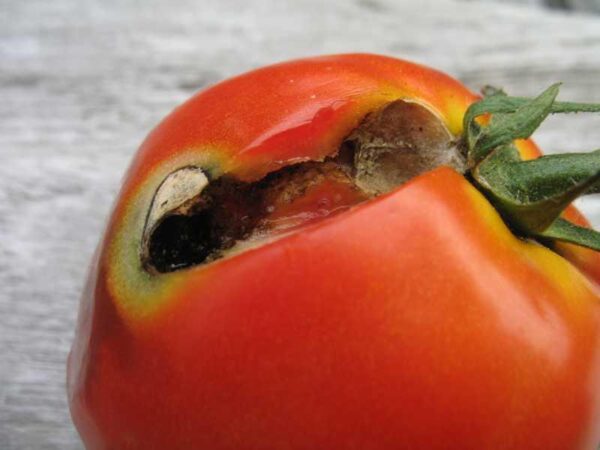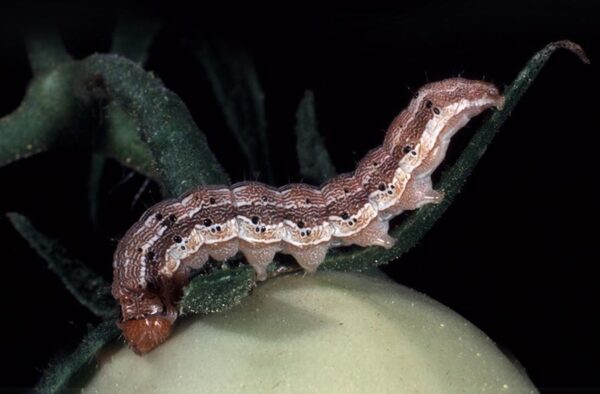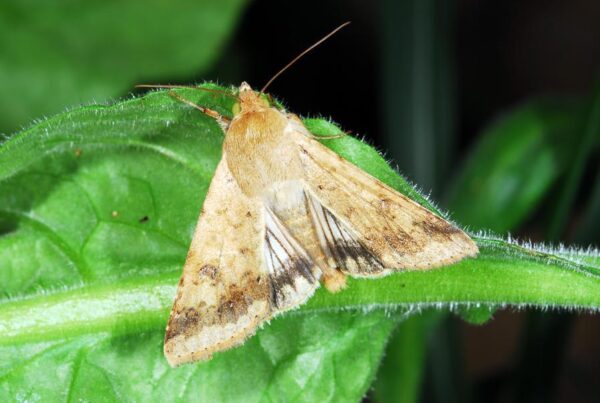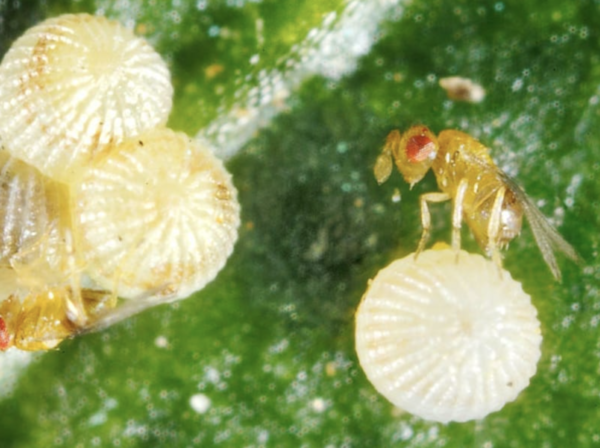by Sylvia Reed, Davidson College | Wednesday, July 18, 2023 –

Fruit damage caused by tomato fruitworm
The tomato fruitworm (Helicoverpa zea) is found across North America and is a significant threat to crops in the Carolinas. This pest is also known as the corn earworm or cotton bollworm. The tomato fruitworm has a wide variety of host plants and is most known to feed on tomatoes, corn, and cotton. It can also feed on a number of weed species, including sunflower, pigweed, ragweed, horsenettle, lambsquarters, hemp, common mallow, and morning glory. Because the tomato fruitworm is hosted by many crops and weeds, it can be difficult to eradicate the pest entirely. Tomato fruitworms damage crops by burrowing into and eating the fruits and stems of plants. In tomatoes specifically, they hollow out the fruit and leave behind water and feces, leading the fruit to rot. With corn, tomato fruitworms are mainly drawn to the corn silk at the top of the ear. The damage from tomato fruitworms results in destroyed kernels and fungus, leaving an often unsellable piece of corn. All fruits consumed by the tomato fruitworm are left unmarketable, leading to reduced yield and profit for growers.
Due to the warm Southern climate, the Carolinas are especially susceptible to the tomato fruitworm. Fruitworms can overwinter as pupa in the top few inches of soil, making them present and problematic for the entire growing season. Contrastingly, in more northern climates, tomato fruitworms may arrive in fields later in the season, which minimizes crop damage. The following article outlines the main identifiers of the tomato fruitworm, and different sustainable management strategies growers can use to minimize the negative impact of this pest on their crops.
Identifying the Tomato Fruitworm
The eggs of the tomato fruitworm are laid singly on the tops or bottoms of leaves. They are small, spherical but slightly flattened, and have slight striations. The eggs can appear white, cream-colored, or pale yellowish-green. Tomato fruitworm caterpillars hatch as caterpillars after 2-10 days (depending on the temperature), with caterpillars ranging in color from light and dark brown to black or green. All caterpillars have alternating light and dark stripes running lengthwise down their bodies and have brown heads. These caterpillars also vary in size as they develop, ranging from 0.1 to 1.5 inches long. As adults, the tomato fruitworm is a medium-sized, nocturnal tan or brown moth with a wingspan of about 1 to 1.5 inches. Adults live for approximately five to fifteen days; a female moth can lay up to 35 eggs in one day and between 500 and 3000 eggs in its lifetime. One season can support up to four generations of tomato fruitworms, allowing fruitworm populations to get out of control if not properly managed.

Tomato fruitworm in caterpillar stage
Management Practices
One management strategy effective in fighting off the tomato fruitworm is trap cropping – a sustainable practice that reduces pesticide dependence by incentivizing alternative host plants for the specific pest. For tomato fruitworms, the best trap crops are sorghum and pigeon pea. These trap crops are most effective when used to protect cotton and okra. The NK300 variety of sorghum is known to be an excellent trap crop and is bred to be dependable in a wide range of conditions. Other growers have planted corn borders around tomato fields to draw away fruitworms from tomatoes. This works as a trap crop because tomato fruitworms are highly attracted to corn silk, especially for egg laying. Using corn as a trap crop is not preferred if you want to sell the corn as a cash crop later. However, some may find the loss of the corn used in the corn borer worth it if it saves the tomato field.
One factor to consider in trap cropping is flowering time. Because tomato fruitworm moths are attracted to flowering plants, farmers should synchronize the trap crop’s flowering with the cash crop’s flowering to minimize attraction to the cash crop. One possible risk with trap cropping is that the tomato fruitworm simply uses the trap crop to lay eggs, then once hatched, the caterpillars may move on to destroy the cash crops. This can be avoided by removing the trap crop after the egg-laying period for the tomato fruitworm. For example, when using corn as a trap crop, growers should remove the plant after silking to eradicate the eggs and caterpillars in the corn silk. Generally, one should expect to allocate 10% to 15% of a field to trap crops and plant these about 6 to 10 feet away from cash crops. Planting trap crops inside high tunnels is also not recommended due to limited space. Instead, one should plant trap crops directly outside. Trap crops should be planted before cash crops to minimize predation of cash crops during their vulnerable early stages of life.

Tomato fruitworm in adult moth stage
Another popular strategy for managing tomato fruitworms is using natural predators and parasitoids. One of the most common natural enemies of fruitworms is Trichogramma pretiosum, a tiny wasp that parasitizes the eggs of tomato fruitworms. These wasps are native to the Carolinas, but natural populations are often not large enough to make significant differences in pest populations. Species in the Trichogramma family are easy to purchase, raise, and release in large numbers, and predate various crop pests. After being released, the wasps locate and lay their eggs inside the tomato fruitworm eggs. Once the wasp caterpillars hatch, they consume the tomato fruitworm eggs. Previous studies have found that releasing this natural predator into fields can result in 55.7% and 81.2% parasitization of the tomato fruitworm eggs, killing the fruitworms.
This form of biological control can effectively prevent tomato fruitworms from reaching high numbers in agricultural fields. Adult Trichogramma pretiosum eat nectar, so farmers should plant flowers or flowering plants nearby if they plan on releasing a wasp population. One limitation to this management practice is the lifespan of Trichogramma pretiosum – adults only live for up to two weeks. Additionally, Trichogramma pretiosum can only predate the tomato fruitworm during the egg stage. Therefore, timing the release of Trichogramma pretiosum is crucial. Growers should release wasps into fields at the first sign of tomato fruitworm eggs if adding purchased wasps. Additional natural predators of the tomato fruitworm include the minute pirate bug, the big-eyed bug, lacewings, and Hyposoter exiguae, another parasitic wasp species.

Parasitic wasp lays an egg in the egg of tomato fruitworm
The tomato fruitworm is a very damaging and persistent pest for a wide variety of crops, with the main targets being tomatoes, corn, and cotton. As caterpillars, they range in size from 0.1 to 1.5 inches and are either brown, black, or green. They have alternating stripes lengthwise on their bodies and brown heads. The adult moths are tan or brown with a wingspan of 1 to 1.5 inches.
Using sorghum, pigeon peas, and corn as trap crops effectively manage the tomato fruitworm. Additionally, promoting natural predators can significantly reduce the negative impact of tomato fruitworms. This includes Trichogramma pretiosum, a wasp that parasitizes tomato fruitworm eggs. Through general knowledge of the pest and the practices of trap cropping, enhancement of natural predators, and management of weeds on which fruitworms feed, growers can manage the spread of tomato fruitworms. These management strategies have the potential to save significant amounts of crops – and money – for farmers in the Carolinas.
Additional Information
General information on the tomato fruitworm.
Additional management information.
More information on Trichogramma pretiosum and how to purchase them.
More information on NK300 sorghum.
About the Author
My name is Sylvia Reed, and I am a senior at Davidson College majoring in Environmental Studies on the Natural Science Track. I love taking Biology and Environmental Science classes, especially when we get to spend time outside. I am originally from Austin, Texas, and have always been interested in farming and agriculture. It has been really interesting to learn about the complexities of sustainable farming throughout the course of this semester.


